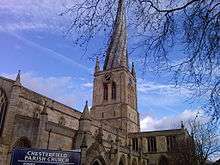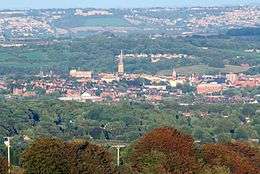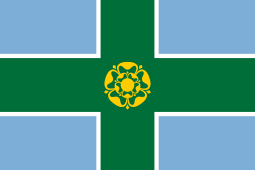Church of St Mary and All Saints, Chesterfield
| Chesterfield Parish Church | |
|---|---|
| The Parish Church of St. Mary and All Saints, Chesterfield | |
 | |
| 53°14′10″N 1°25′27″W / 53.236111°N 1.424167°WCoordinates: 53°14′10″N 1°25′27″W / 53.236111°N 1.424167°W | |
| Location | Chesterfield, Derbyshire |
| Country | England |
| Denomination | Church of England |
| Churchmanship | Liberal |
| Website | Official Website |
| History | |
| Dedication | St. Mary and All Saints |
| Architecture | |
| Status | Parish Church |
| Functional status | Active |
| Completed |
14th century |
Listed Building – Grade I | |
| Official name | Parish Church of St Mary and All Saints |
| Designated | 15 July 1971 |
| Reference no. | 1334708 |
| Specifications | |
| Number of spires | 1 |
| Spire height | 70m |
| Materials | Lead |
| Administration | |
| Parish | Chesterfield |
| Deanery | Chesterfield |
| Archdeaconry | Chesterfield |
| Diocese | Derby |
| Province | Canterbury |
| Clergy | |
| Vicar(s) | Patrick Coleman |
| Laity | |
| Churchwarden(s) |
Mr Colin McKenna Dr Malcolm Wilkinson |
Chesterfield Parish Church is an Anglican church dedicated to Saint Mary and All Saints, located in the town of Chesterfield in Derbyshire, England. Predominantly dating back to the 14th century, the church is a Grade I listed building[1] and is most known for its twisted spire, an architectural phenomenon which has led to the church being given the common byname of the Crooked Spire. The largest church in Derbyshire, it lies within the Diocese of Derby, in which it forms part of the Archdeaconry of Chesterfield.[2][3]
History
The church is largely medieval with Early English, Decorated Gothic and Perpendicular Gothic features built of ashlar.[4] It comprises a nave, aisles, north and south transepts and the chancel which is surrounded by four guild chapels.
The north transept was rebuilt in 1769 and George Gilbert Scott carried out a restoration in 1843, when a new ceiling was installed and a new east window inserted with stained glass by William Wailes of Newcastle. A new font was donated by Samuel Johnson of Somersal Hall. The church reopened on 9 May 1843.[5]
Lightning struck the church spire on 11 March 1861 which snapped the gas lighting pipes in the tower and a fire started in a beam next to the wooden roof of the chancel. The fire smouldered for three and a half hours until it was discovered by the Sexton on his nightly round to ring the midnight bell.[6]
A further restoration was begun in 1896 by Temple Lushington Moore.[7] Moore designed the High Altar reredos, installed in 1898.
A fire on 22 December 1961 destroyed many of the interior fittings, including the Snetzler organ. Surviving elements include the south transept screen from c. 1500, the Norman font and a Jacobean pulpit.
The crooked spire

The spire was added to the 14th-century tower in about 1362.[8] It is both twisted and leaning, twisting 45 degrees and leaning 9 ft 6 in (2.9 m) from its true centre. The leaning characteristic was initially suspected to be the result of the absence of skilled craftsmen (the Black Death had been gone only twelve years before the spire's completion), insufficient cross bracing, and the use of unseasoned timber.
It is now believed that the twisting of the spire was caused by the lead that covers the spire. The lead causes this twisting phenomenon, because when the sun shines during the day the south side of the tower heats up, causing the lead there to expand at a greater rate than that of the north side of the tower, resulting in unequal expansion and contraction. This was compounded by the weight of the lead (approximately 33 tonnes) which the spire's bracing was not originally designed to bear. Also it was common practice to use unseasoned timber at the time the spire was built as when the wood was seasoned it was too hard to work with, so as unseasoned wood was used they would have made adjustments as it was seasoning in place.
In common folklore, there are numerous explanations as to why the spire is twisted.[9] One well-established legend goes that a virgin once married in the church, and the church was so surprised that the spire turned around to look at the bride, and continues that if another virgin marries in the church, the spire will return to true again. Several local legends hold that the Devil was responsible. In one tale, a Bolsover blacksmith mis-shod the Devil, who leapt over the spire in pain, knocking it out of shape. A similar story has the Devil causing mischief in Chesterfield, seating himself on the spire and wrapping his tail around it. The people of the town rang the church bells and the Devil, frightened by the clamour, tried to jump away with his tail still wound about the spire, causing it to twist.
The tower upon which the spire sits contains ten bells. These bells were cast in 1947 by the Whitechapel Bell Foundry in London, replacing a previous ring. The heaviest weighs 1,270 kg (25 long hundredweight). The place in which the bells are situated once held the builders' windlass, which is one of the few examples of a medieval crane in existence and is the only example of one that has survived from a parish church. The windlass is now on display at Chesterfield Museum and Art Gallery.
It is this twisted spire that gives the town's football club, Chesterfield F.C., their nickname, 'the Spireites'. A depiction of the spire also features on the club's crest.
Tours
The spire is open to the public most days (except Sundays and Good Friday) and can be climbed partway up.[10] The views from the top of the tower on a clear day stretch for miles. The spire, which is used as a symbol of Chesterfield, can often be seen from the surrounding hill poking out of a sea of mist, on a winter morning.
Vicars
- Martin Lane 1558–1573
- Cuthbert Hutchinson 1573–1609
- Matthew Waddington 1616–?
- William Edwards 1638–?
- John Billingsley 1662–1663
- John Coope 1663–?
- John Lobley ?–1694
- William Blakeman 1694–1699
- Henry Audsley 1699–1705
- John Peck 1705–1707
- William Higgs 1707–1716
- Thomas Hinckesman 1716–1739
- William Wheeler 1739–1765
- John Wood 1765–1781
- George Bossley 1781–1822
- Thomas Hill 1822–? (Archdeacon of Derby)
- George Butt ?–1888
- Hon. Reginald Edmund Adderley 1888–1892
- Hon. Cecil James Littleton 1893–1898
- Egbert Hacking 1899–1905
- Edmond Francis Crosse 1905–? (Archdeacon of Chesterfield)
- Francis Longsdon Shaw 1918–1924
- Geoffrey Hare Clayton 1924–1934 (Archdeacon of Chesterfield)
- Talbot Dilworth-Harrison 1934–? (Archdeacon of Chesterfield)
- Thomas Wood Ingram Cleasby 1963–1970 (Archdeacon of Chesterfield)
- Thomas Ewart Roberts 1971–1975
- Henry Alexander Puntis ?–?
- Brian Hamilton Cooper 1982–1991
- Martyn William Jarrett 1991–1994
- Michael Richard Knight 1994–2013
- Patrick Francis Coleman 2014–present[11]
Organ
The vast majority of the original John Snetzler organ (1756) was destroyed by fire in 1961.[12] It was replaced in 1963 by a redundant T. C. Lewis organ from Glasgow. This is a large four-manual pipe organ with 65 stops. A specification of the organ can be found on the National Pipe Organ Register.[13]
List of organists
Gallery
 View of the church and spire
View of the church and spire General view of Chesterfield from a distance, including the spire
General view of Chesterfield from a distance, including the spire- The church in the 18th century as sketched by Samuel Hieronymus Grimm
- The church in the snow, February 2009
- The high altar
 Church of St Mary and All Saints – "The Crooked Spire"
Church of St Mary and All Saints – "The Crooked Spire"
References
- ↑ Historic England, "Church of St Mary and All Saints (1334708)", National Heritage List for England, retrieved 8 April 2015
- ↑ "The Chesterfield Parish Church". Parish Church of St Mary and All Saints. 2005. Retrieved 4 January 2009.
- ↑ "Crooked Spire Church". Visit Chesterfield & Bolsover. Retrieved 13 May 2011.
- ↑ Pevsner, Nikolaus (1978). The Buildings of England: Derbyshire. Revised by Elizabeth Williamson. Penguin Books. p. 140–141. ISBN 0-14-071008-6.
- ↑ "Reopening of Chesterfield Church". Derby Mercury. Derby. 17 May 1843. Retrieved 8 April 2015.
- ↑ "Fire at Chesterfield Church". Sheffield Independent. Sheffield. 16 March 1861. Retrieved 8 April 2015.
- ↑ "Chesterfield Parish Church Restoration. Appointment of an Architect". Derbyshire Times and Chesterfield Herald. Derby. 30 May 1896. Retrieved 8 April 2015.
- ↑ "About The Spire". Parish Church of St Mary and All Saints. Archived from the original on 1 November 2010. Retrieved 13 May 2011.
- ↑ "Tales Of Virgins, The Devil And The Crooked Spire". Chesterfield Post. Retrieved 14 March 2016.
- ↑ "Church Visits". The Parish Church of St Mary and All Saints. Retrieved 31 December 2015.
- ↑ "New vicar for Crooked Spire in Chesterfield". Derbyshire Times. Retrieved 2 September 2014.
- ↑ "The Derbyshire Times remembers the Spire fire". Derbyshire Times. 22 December 2011. Retrieved 23 December 2011.
- ↑ Derbyshire, Chesterfield: St. Mary and All Saints, Church Way (N01874), National Pipe Organ Register, UK, 2005.
- ↑ "Chesterfield Organ". Derbyshire Courier. Sheffield. 1 January 1848. Retrieved 8 April 2015.
- ↑ Who's Who in Music (First Post War ed.). Shaw Publishing Ltd. 1949–50.
External links
![]() Media related to Church of St Mary and All Saints, Chesterfield at Wikimedia Commons
Media related to Church of St Mary and All Saints, Chesterfield at Wikimedia Commons
- Parish Church of St Mary and All Saints
- Derbyshire churches — Church of Our Lady and All Saints at Chesterfield
